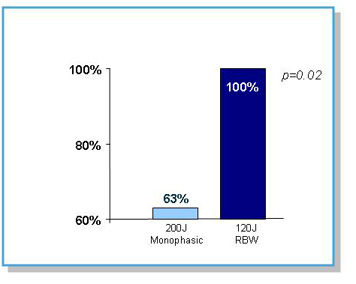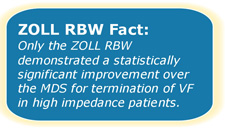Biphasic Technology - Superior for VF
Superior for Defibrillation of Ventricular Fibrillation
The performance of the ZOLL Rectilinear Biphasic™ waveform (RBW) stands out again in defibrillation of ventricular fibrillation in the Electrophysiology Lab. Three separate clinical trials were conducted for three different biphasic waveforms-each was compared to the same common standard, monophasic damped sine (MDS) waveform (Figure 1).
The ZOLL RBW was the only biphasic waveform to demonstrate statistical superiority to a 200 J MDS shock at low energy settings-99% efficacy at 120 J.* Only 1 patient in the study required a second shock at 150 J to interrupt VF. Furthermore, the results of the RBW became even more significant when the patient population was segregated into just high impedance patients (greater than 90 ohms) - 100% first shock efficacy at 120 J for RBW vs. 63% first shock efficacy at 200 J for MDS (p=0.02) (Figure 2). |
|
Biphasic Results for VF (Figure 1) |
|
Mittal et. al. (Figure 2) |
|
Learn More about ZOLL's Rectilinear Biphasic Waveform: Principles of Electricity *The data demonstrates the equivalent efficacy of low energy rectilinear biphasic shocks compared to standard high energy monophasic shocks for transthoracic defibrillation for all patients in VT/VF at the 95% confidence level. The data also demonstrate the superior efficacy of low energy rectilinear biphasic shocks compared to standard high energy monophasic shocks in patients in VT/VF with high transthoracic impedance at the 90% confidence level. |


